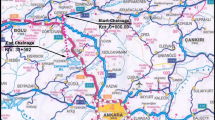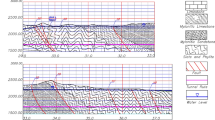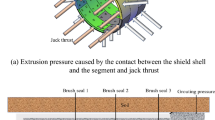Abstract
Cutterhead torque and thrust are the two main designing parameters of the shield TBM, which have to be evaluated and optimized, based on the interaction between the TBM and excavated material. This study employs the discrete element method (DEM) to simulate the tunneling procedure of the line-7 of Tehran underground urban train tunnel utilizing the micro mechanical parameters calculated from back analysis on direct shear tests. The resultant torque and thrust are then compared against the actual parameters and then with those estimated from the numerical analyses. This result shows that DEM is able to estimate the TBM torque and thrust applying actual boundary conditions and material properties for the model. Furthermore, the impact of ground properties, overburden height, linear and radial velocity on cutterhead torque and thrust and its performance are evaluated and optimized.














Similar content being viewed by others
References
Acaroglu O (2011) Prediction of thrust and torque requirements of TBMs with fuzzy logic models. Tunn Undergr Sp Technol 26:267–275
Ates U, Bilgin N, Copur H (2014) Estimating torque, thrust and other design parameters of different type TBMs with some criticism to TBMs used in Turkish tunneling projects. Tunn Undergr Sp Technol 40:46–63
Bagi K (2005) An algorithm to generate random dense arrangements for discrete element simulations of granular assemblies. Granul Matter 7:31–43
Cundall PA, Strack ODL (1979) A discrete numerical model for granular assemblies. Geotechnique 29:47–65
Cundall PA, Drescher A, Strack ODL (1982) Numerical experiments on granular assemblies; measurements and observations. In: Deformation and failure of granular materials. IUTAM symposium, Delft, 1982. AA Balkema, pp 355–370
EFNARC A (2005) Specifications and Guidelines for the use of specialist products for mechanized tunnelling (TBM) in soft ground and hard rock. Recomm Eur Fed Prod Contract Spec Prod Struct 1:18–30
Fatemi SA, Ahmadi M, Rostami J (2016) Evaluation of TBM performance prediction models and sensitivity analysis of input parameters. Bull Eng Geol Environ 77:501–513
Hamidi JK, Shahriar K, Rezai B, Rostami J (2010) Performance prediction of hard rock TBM using rock mass rating (RMR) system. Tunn Undergr Sp Technol 25:333–345
Hasanpour R, Rostami J, Ünver B (2014) 3D finite difference model for simulation of double shield TBM tunneling in squeezing grounds. Tunn Undergr Sp Technol 40:109–126
Herzog M (1985) Surface subsidence above shallow tunnels (in German). Bautechnik 62:375–377
Huang H (1999) Discrete element modeling of tool-rock interaction, Ph.D. dissertation, University of Minnesota
Itasca Consulting Group (1999) PFC3D (Particle flow code in 3 Dimensions), User’s manual
Jakobsen PD, Langmaack L, Dahl F, Breivik T (2013) Development of the soft ground abrasion tester (SGAT) to predict TBM tool wear, torque and thrust. Tunn Undergr Sp Technol 38:398–408
Kasper T, Meschke G (2006) On the influence of face pressure, grouting pressure and TBM design in soft ground tunnelling. Tunn Undergr Sp Technol 21:160–171
Kavvadas M, Litsas D, Vazaios I, Fortsakis P (2017) Development of a 3D finite element model for shield EPB tunnelling. Tunn Undergr Sp Technol 65:22–34
Khademian Z, Shahriar K, Nik MG (2012) Developing an algorithm to estimate in situ stresses using a hybrid numerical method based on local stress measurement. Int J Rock Mech Min Sci 55:80–85
Khademian Z, Poeck E, Garvey R, Ozbay U (2016) Studies of seismicity generated by unstable failures around circular excavations. In: 50th US Rock mechanics/geomechanics symposium. American Rock Mechanics Association
Labra C, Rojek J, Onate E (2017) Discrete/finite element modelling of rock cutting with a TBM disc cutter. Rock Mech Rock Eng 50:621–638
Larson M, Kraus NC, Byrnes MR (1990) SBEACH: Numerical model for simulating storm-induced beach change. Report 2. Numerical formulation and model tests. Department of the army US Army corps of engineers Washington, DC 20314-1000 under calculation of cross-shore sediment transport and beach profile change work unit 32530
Lee KM, Rowe RK, Lo KY (1992) Subsidence owing to tunnelling. I. Estimating the gap parameter. Can Geotech J 29:929–940
Lei ST, Kaitkay P (2003) Distinct element modeling of rock cutting under hydrostatic pressure. In: Key engineering materials, vol. 250. Trans Tech Publications, pp 110–117
Ma H, Gong Q, Wang J et al (2016) Study on the influence of confining stress on TBM performance in granite rock by linear cutting test. Tunn Undergr Sp Technol 57:145–150
Maynar MJ, Rodríguez LE (2005) Discrete numerical model for analysis of earth pressure balance tunnel excavation. J Geotech Geoenvironmental Eng 131:1234–1242
Melis M, Medina L, Rodríguez JM (2002) Prediction and analysis of subsidence induced by shield tunnelling in the Madrid Metro extension. Can Geotech J 39:1273–1287
Michael K, Dimitris L, Ioannis V, Petros F (2017) Development of a 3D finite element model for shield EPB tunneling. Tunn Undergr Sp Technol 65:22–34
O’Carroll JB (2005) A Guide to planning, constructing, and supervising earth pressure balance TBM tunneling. Parsons Brinckerhoff, New York
Poeck EC, Khademian Z, Garvey R, Ozbay U (2016) Modeling unstable rock failures in underground excavations. In: ISRM international symposium-EUROCK 2016. International Society for Rock Mechanics and Rock Engineering
Potyondy DO, Cundall PA (2004) A bonded-particle model for rock. Int J Rock Mech Min Sci 41:1329–1364
Ramoni M, Anagnostou G (2010) Thrust force requirements for TBMs in squeezing ground. Tunn Undergr Sp Technol 25:433–455
Rojek J, Onate E, Labra C, Kargl H (2011) Discrete element simulation of rock cutting. Int J Rock Mech Min Sci 996–1010
Salimi A, Rostami J, Moormann C, Delisio A (2016) Application of non-linear regression analysis and artificial intelligence algorithms for performance prediction of hard rock TBMs. Tunn Undergr Sp Technol 58:236–246
Shi H, Yang H, Gong G, Wang L (2011) Determination of the cutterhead torque for EPB shield tunneling machine. Autom Constr 20:1087–1095
Song X, Liu J, Guo W (2010) A cutter head torque forecast model based on multivariate nonlinear regression for EPB shield tunneling. In: 2010 international conference on artificial intelligence and computational intelligence. IEEE, pp 104–108
Wu L, Guan T, Lei L (2013) Discrete element model for performance analysis of cutterhead excavation system of EPB machine. Tunn Undergr Sp Technol 37:37–44
Zhang K, Yu H, Liu Z, Lai X (2010) Dynamic characteristic analysis of TBM tunnelling in mixed-face conditions. Simul Model Pract Theory 18:1019–1031
Acknowledgements
The authors would like to thank Sepasad Co. for providing us with the required information for this research.
Author information
Authors and Affiliations
Corresponding author
Additional information
Publisher's Note
Springer Nature remains neutral with regard to jurisdictional claims in published maps and institutional affiliations.
Rights and permissions
About this article
Cite this article
Faramarzi, L., Kheradmandian, A. & Azhari, A. Evaluation and Optimization of the Effective Parameters on the Shield TBM Performance: Torque and Thrust—Using Discrete Element Method (DEM). Geotech Geol Eng 38, 2745–2759 (2020). https://doi.org/10.1007/s10706-020-01183-y
Received:
Accepted:
Published:
Issue Date:
DOI: https://doi.org/10.1007/s10706-020-01183-y




